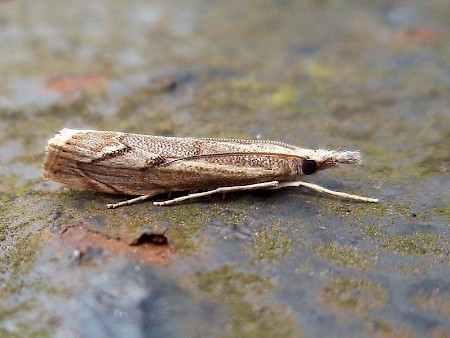63.095 BF1309
Agriphila geniculea
(Haworth, 1811)
Wingspan 20-25 mm.
The strongly elbowed cross-lines generally serve to distinguish this moth, but on some specimens the lines are obscure.
It is an inhabitant of dry, grassy areas, sand-dunes and similar locations. It flies from July to October, and is present in suitable habitats in much of Britain except the very far north.
The larva, late September to early May, inhabits a flimsy silken gallery mixed with pale frass at the base of small grasses. Sometimes it leaves the gallery and is found curled tightly in a characteristic coil round a thin stem. Short fine grass species, such as Festuca ovina, are preferred.
- Larva: (description Ian F. Smith):
Foodplant: Small grass species such as Festuca ovina.
Length: 9 mm (late October).
Head: Pitchy brown. Yellowish white epicranial notch. Mouthparts pitchy black.
Prothoracic shield: Pitchy black. Divided by indistinct paler medial line.
Thoracic legs: Dark greyish brown.
Body: Brownish yellow, darkest in anterior. Shagreened.
Spiracles: Black
Pinacula: Large shiny greyish brown with fine black setal ring. Unisetose, except bisetose on the thorax and subspiracular pinacula of abdomen. Trisetose pinaculum at base of proleg. The arrangement of dorsal pinacula is in two pairs. On thoracic segments the posterior pair is fused into an elongate transverse pinaculum . On segment A8, the anterior pair is conjoined. On A9 there is just one large bisetose dorsal pinaculum.
Setae: Black.
Anal segment: No anal comb. Anal plate brown with darker flecking, and eight setae with fine black rings at base. Prolegs: Basally pale yellowish, distally brownish grey. Planta pale yellowish. Crochets dark brown. Anal proleg mostly encased in large pale greyish pinaculum.

 UKMoths
UKMoths 







